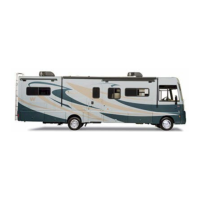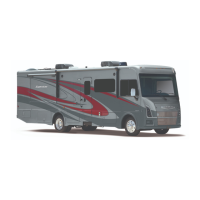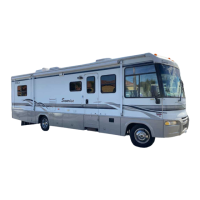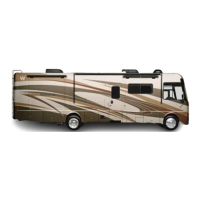
Do you have a question about the Winnebago SightSeer and is the answer not in the manual?
| Brand | Winnebago |
|---|---|
| Model | SightSeer |
| Category | Motorhomes |
| Language | English |
Explains the meaning of DANGER, WARNING, CAUTION, and NOTICE labels used in the manual.
Outlines the dealer's responsibility for inspecting the motor home before shipment and delivery.
Instructs users on how to report potential safety defects to NHTSA and Winnebago Industries.
Describes the label indicating vehicle capacity and its importance for safe loading.
Explains the data on the certification label, including VIN, weight ratings, and tire choices.
Provides detailed measurements and fluid capacities for different motor home models.
Lists essential safety precautions for operating the motor home, including seat belt use and securing items.
Provides critical advice for safe driving, covering seat adjustment, cruise control, and handling adverse conditions.
Details DANGER and WARNINGs regarding refueling and storing flammable materials like propane and gasoline.
Explains procedures for detecting and responding to propane gas leaks within the vehicle.
Warns about the dangers of carbon monoxide and recommends engine exhaust system checks.
Lists crucial safety precautions for handling electrical components, grounding, and circuits.
Advises on properly securing items inside the vehicle to prevent them from becoming projectiles.
Explains how to use the escape window and slider windows as emergency exits.
Details safety warnings for operating slideout rooms, emphasizing clearing obstructions and people.
Outlines safety precautions for accessing and working on the roof and using the ladder.
Offers guidance on handling roadside emergencies, including flat tires and towing.
Advises on actions to take if the engine overheats to prevent damage and ensure safety.
Explains the proper use, adjustment, and care of lap and lap-shoulder seat belts for occupant safety.
Provides guidelines for selecting and properly installing child restraint systems, including tether anchor loops.
Highlights the importance of correct tire pressure for handling, wear, and fuel economy.
Explains the dual power operation of the water heater and quick recovery features.
Provides instructions for starting up, shutting down, and troubleshooting the propane gas furnace.
Explains the propane gas system's role, how it works, and general safety precautions for its use.
Details critical warnings and precautions for handling propane gas, including travel restrictions and leak procedures.
Explains the function of the pressure regulator, its protection, and the need for periodic vent inspection.
Lists critical safety warnings for handling electrical components, grounding, and avoiding overloads.
Explains the 120V AC system, its power sources (shoreline/generator), and connected equipment.
Describes the power center, converter operation, and the distribution of AC and DC power.
Explains the GFCI's role in protecting against electrical shock and how to test and reset it.
Details how to connect and operate the 120-volt generator safely.
Explains the 12V DC system, including chassis battery, house batteries, and power converter.
Explains the function of deep-cycle house batteries for powering living area 12V equipment.
Details how the disconnect switch prevents battery drain during storage.
Explains how to access house batteries and provides essential battery care and maintenance practices.
Describes the fresh water system and its two supply sources: onboard tank or city water.
Explains how the demand pump supplies water from the tank when not connected to city water.
Provides a procedure for disinfecting the potable water system, recommended for new or stored systems.
Explains the self-contained black and gray water holding tanks and their function.
Provides step-by-step instructions for safely dumping the black and gray water tanks at a disposal site.
Details the method of draining and purging waterlines with compressed air for winterization.
Explains the alternative method of filling plumbing lines with non-toxic RV antifreeze for winterization.
Explains how the inverter converts DC to AC power for operating TVs and DVD players from batteries.
Describes the operation of the 600-watt inverter for powering AC devices from house batteries.
Warns that sleeping facilities are not for use while the vehicle is in motion, emphasizing seat belt use.
Explains the electric travel lock system for slideout rooms and how to release/lock them.
Describes the prop-lock rod device used to restrict slideout room movement and its release/securing.
Details the electric operation of slideout rooms, including switch locations and safety warnings.
Covers common troubleshooting steps for electric slideout rooms, including battery voltage and breaker issues.
Provides instructions for manually retracting the front slideout room using a crank in case of electrical failure.
Details the manual retraction procedure for the bedroom slideout room using specialized tools.
Explains the hydraulic leveling system for stabilizing the coach and its control pad location.
Emphasizes the importance of inspecting and maintaining sealants to prevent water intrusion.
Outlines essential steps for preparing the vehicle for storage to minimize potential damage.
Details steps like turning off propane, cleaning, and charging batteries before storage.
Explains how to load the vehicle, emphasizing weight distribution and securing loose items for safety.
Guides on how to weigh the loaded coach to ensure proper distribution and compliance with weight ratings.
Discusses towing capacity, hitch ratings, tongue weight, and the impact of towing on vehicle handling.
Defines GVWR, GAWR, and GCWR, and stresses adherence to weight ratings for safe towing.
Outlines safety precautions for using the roof ladder, including weight limits and proper climbing techniques.










